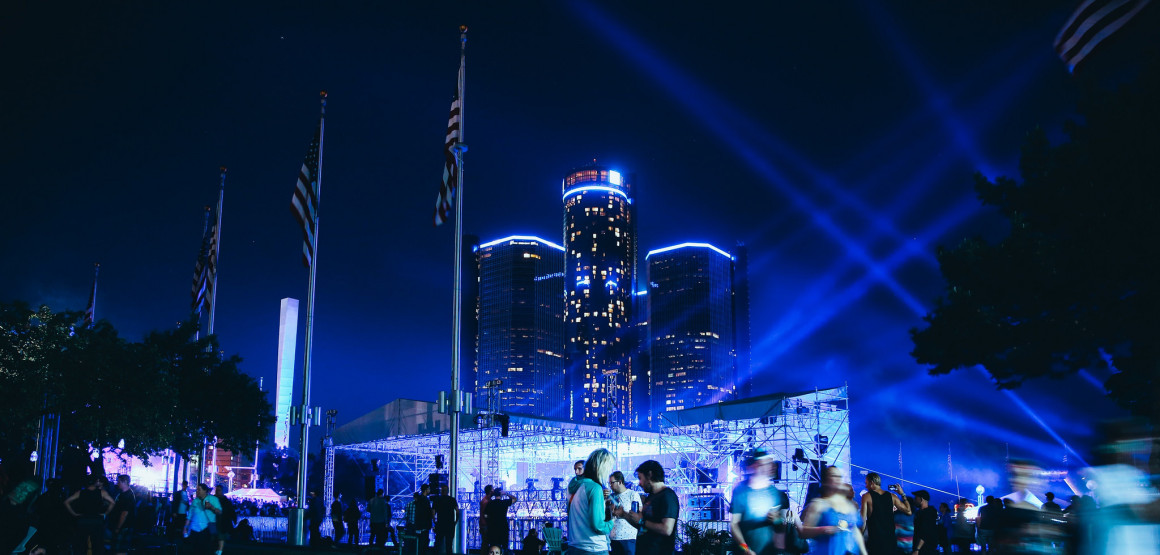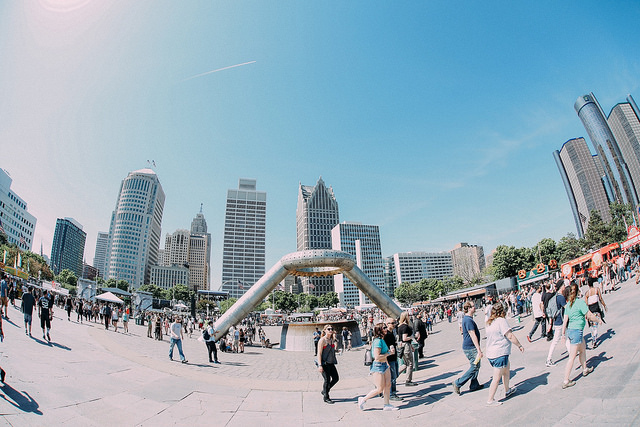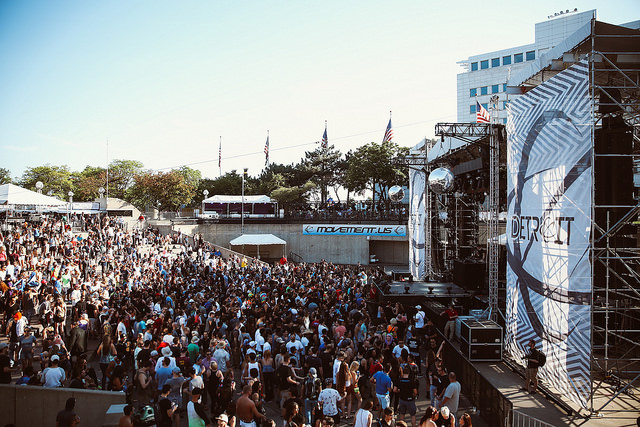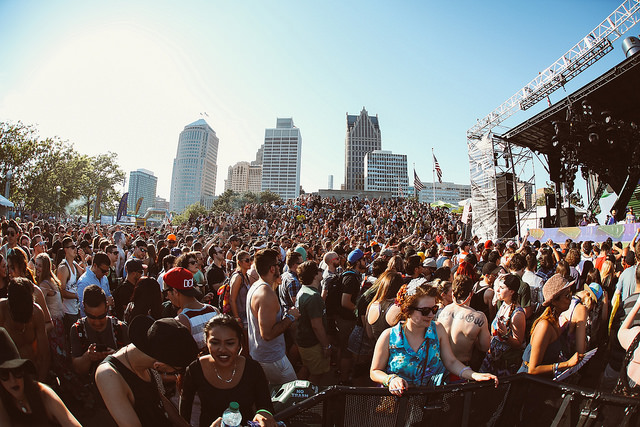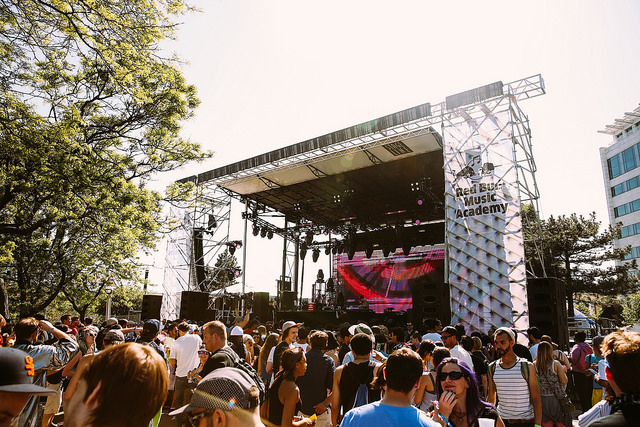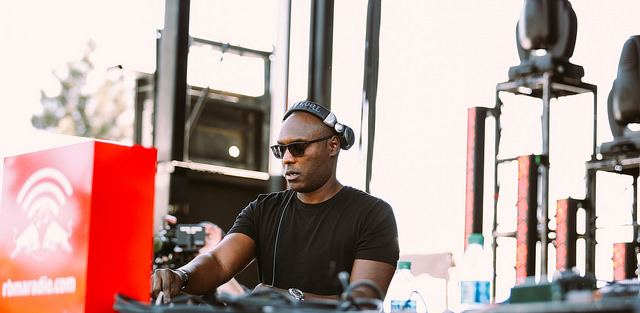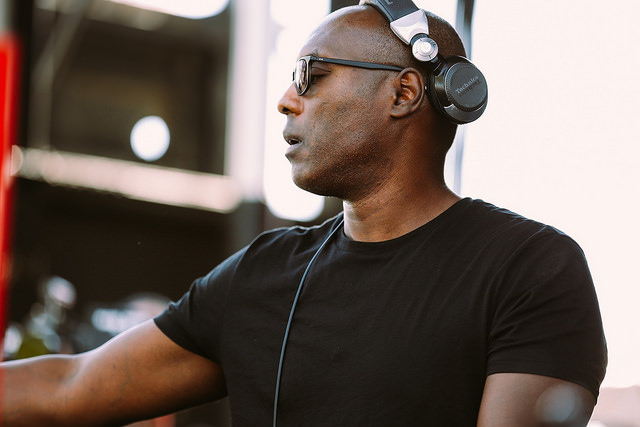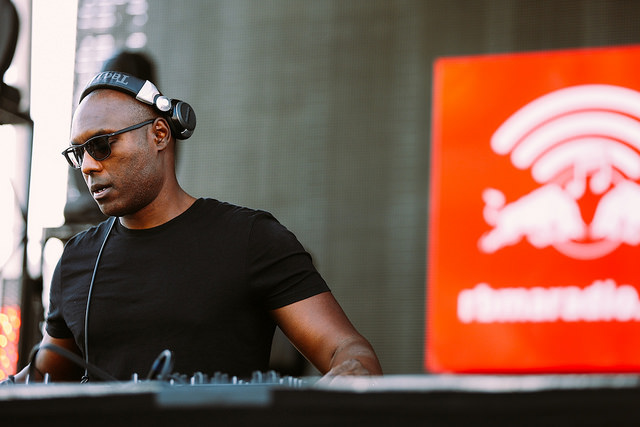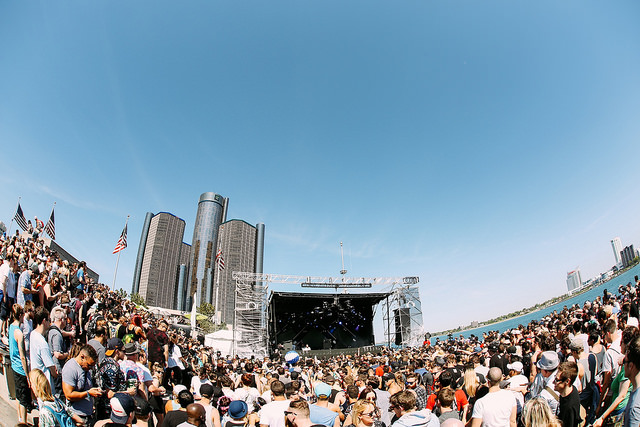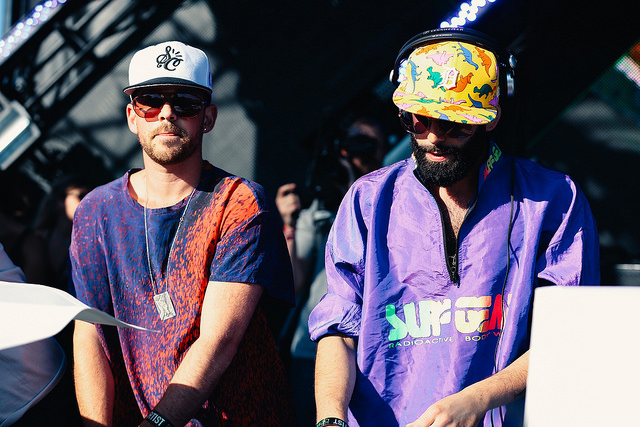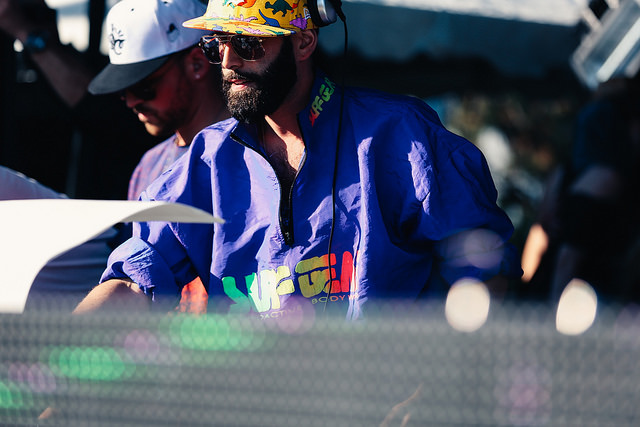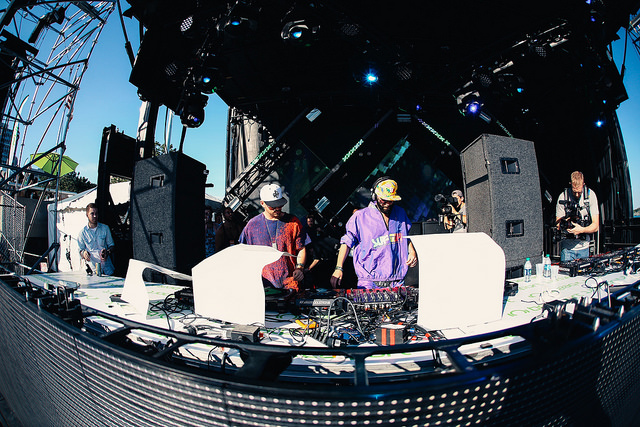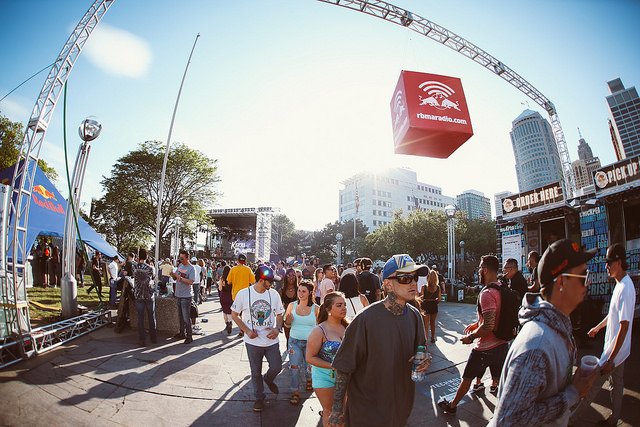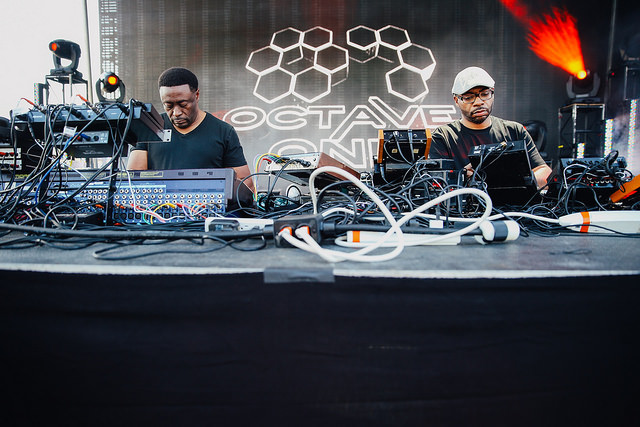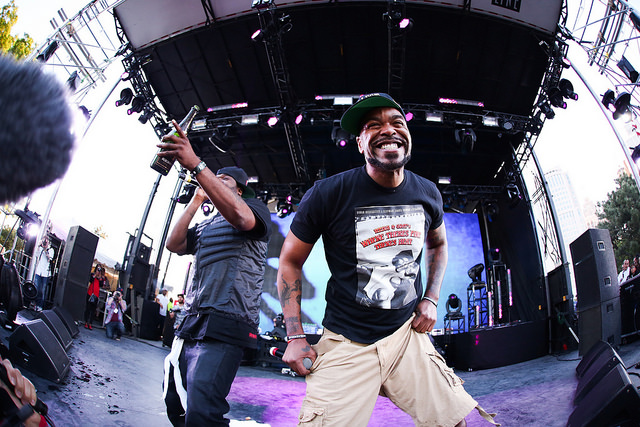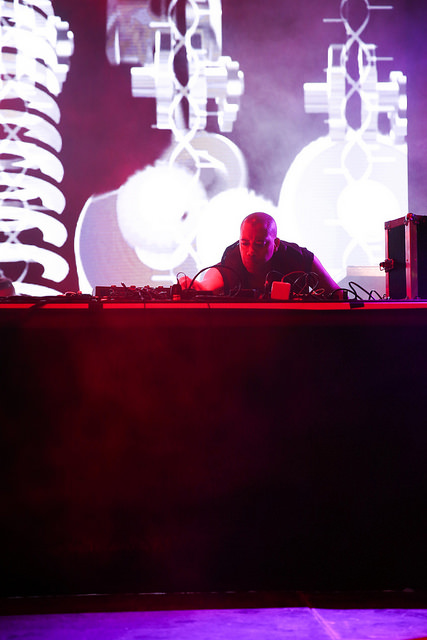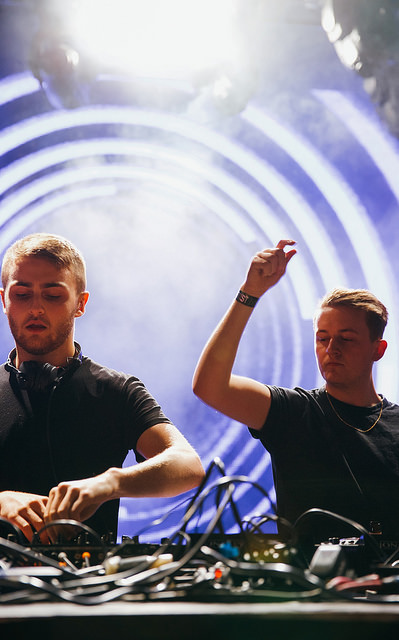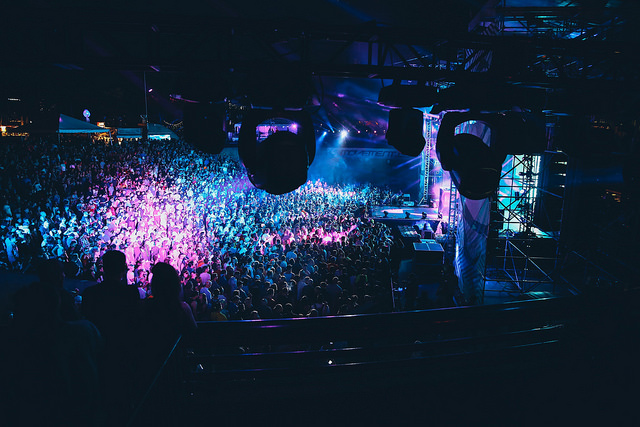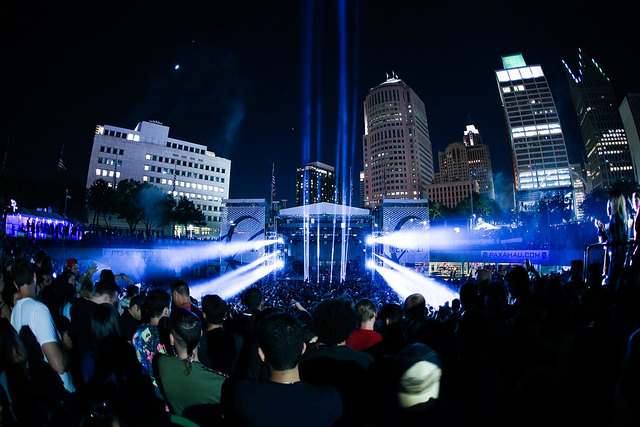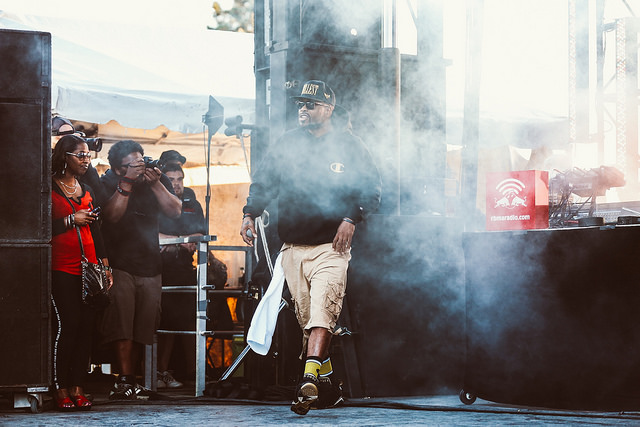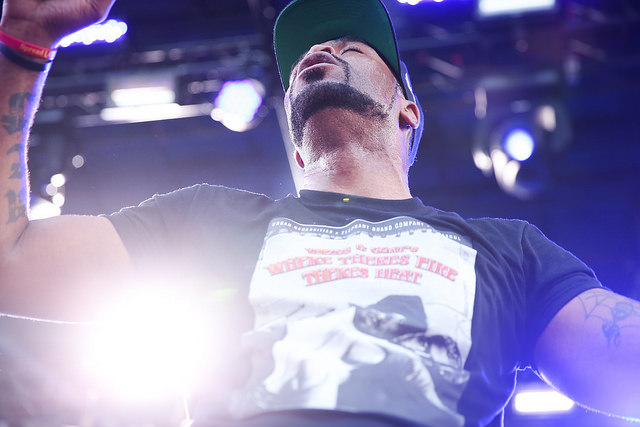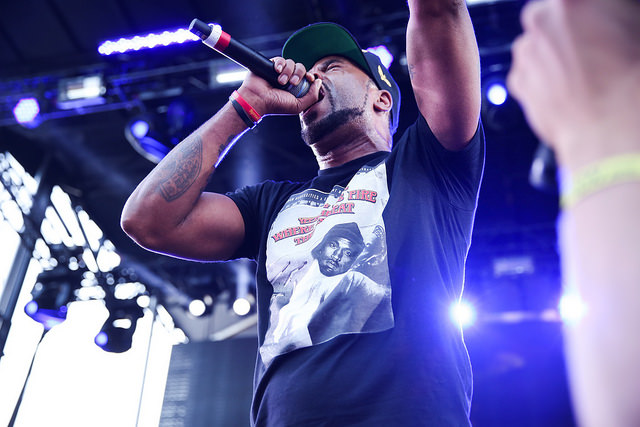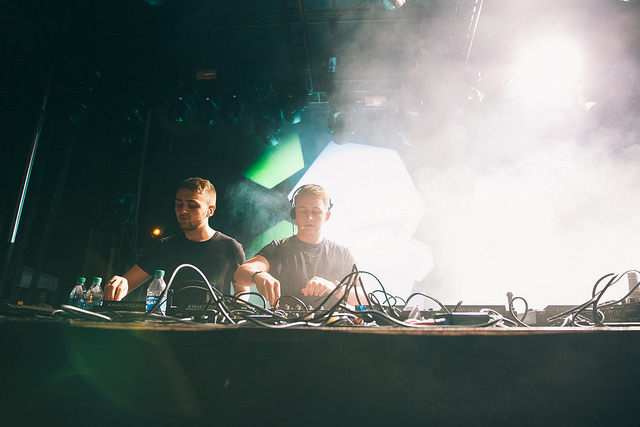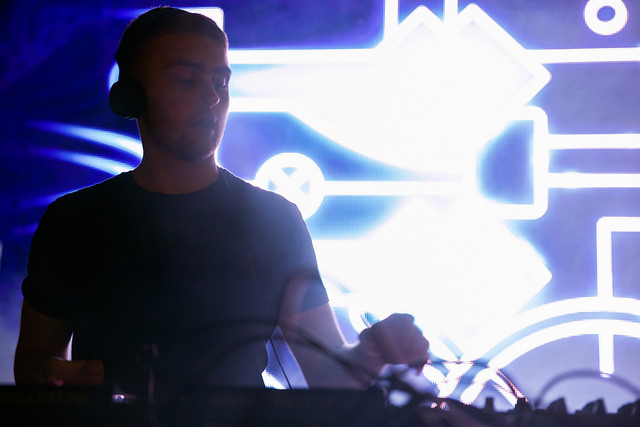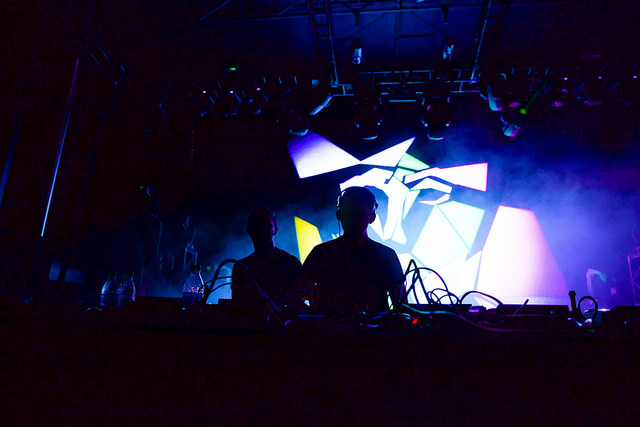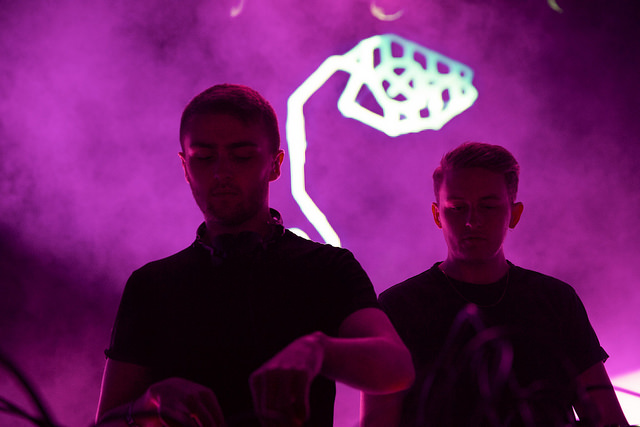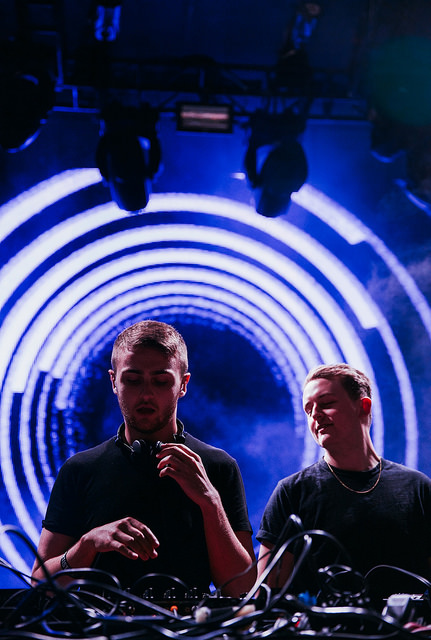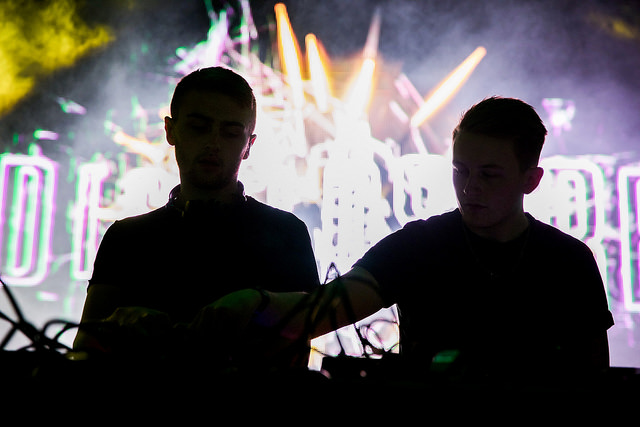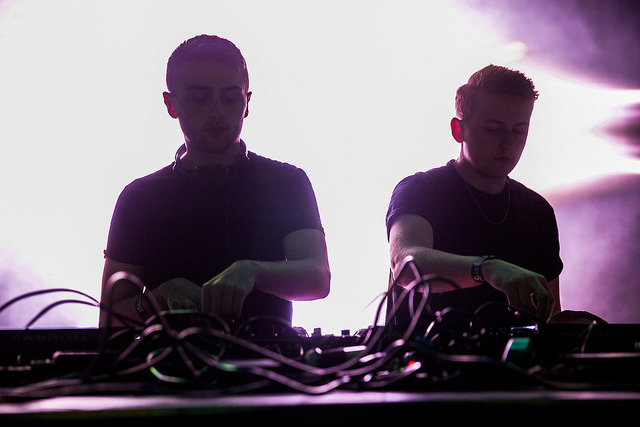Some call it “Techno Christmas,” and some still hold on to the DEMF name of yore; many are there to let their inner freak fly, while many more are there just to take in the sights and sounds. There are native Detroiters, teens who drove in from the suburbs, and tourists flocking in from across the country and abroad — discovering the treasures of a city that has given the world so much and continues to do so. Movement means so many things to so many different people, and as it entered its sixteenth year yesterday, it was easy to see that passion in the throngs of electronic music enthusiasts descending upon Hart Plaza.
That number tipped the 100,000 mark last year for the third time in a row, and with six stages featuring over 100 artists this year, it’s a sure bet that Movement will continue to grow in popularity. The breadth of offerings also guarantees there’s something for nearly everyone’s tastes, from the staunchest purists to casual fans. A quick lay of the land reveals this easily:
- Movement Stage: This is the big one, the stage that gets the most press and is included in most publicity shots and PR campaigns. It’s the stage that’s named after the actual festival and features the greatest number of marquee names. If you’ve made it here, you’re probably doing something right.
- Red Bull Music Academy Stage: Secluded a bit in a grassy area just past the Movement Stage, the RBMA is one of the most eclectic bills of the festival, featuring a mix of both cutting-edge and old school hip-hop, experimental electronic music, and pop-minded acts. Squint your eyes and you might think you were at Electric Forest.
- Beatport Stage: The proximity to the water, the concrete ziggurat just to the right of the stage, and the hordes of people dancing en masse to the uptempo sets on this beachy arena lend it a vibe that recalls Miami’s Ultra.
- Thump Stage: Closest to Jefferson Avenue and closest to The Spirit of Detroit, with its music spilling out on to the street, the Thump Stage truly is the one made for the people of our city and features a showcase each day on different facets of Detroit’s electronic music legacy.
- Underground Stage: You have to descend into the depths of Hart Plaza to access these wares. This stage is the truest to its name, highlighting the bubbling under developments of electronic music. It’s a grittier environment, but the subterranean nature of the surroundings will reward you with some surprising discoveries.
- Sixth Stage: A nondescript name for — you guessed it — the sixth stage of the festival, the Sixth Stage features some left-of-center acts that don’t quite fit in elsewhere, but they shouldn’t be counted out, especially the Konkrete Detroit Jungle and Detroit Techno Militia Showcases.
With so much music to choose from, it’s impossible to see or hear it all. That being said, here are some of our highlights from the first day of Movement 2015:
To close out his set, house producer and Three Chairs Collective member Rick Wilhite paid tribute to the late J Dilla; it was not only a fitting homage to one of Detroit’s most influential beatmakers but also a way for Wilhite to show his own affinity for cratedigging and rare vinyl grooves. In the early afternoon, as people were still starting to trickle into the festival, the crackling pops and dusty whirl of the samples promised that the party was just getting started.
And then, Kenny Larkin. Without introduction, the artist took to the stage and set down a martial beat, over which a disembodied voice remarked about “power” and “time zones” and “the Soviet Union.” Larkin, who missed out on the early years of Detroit techno due to his service in the military, had the Cold War on his mind on this warm late spring day. But he’s also a man that started a stand up comedy career late in life, and when a few young men clad in Sriracha-brand shirts wandered the crowd during this stretch of the set, the humor of the confluence of Communist red, Red Bull, and that infamous red bottle was not lost on many.
But back to the music. If he who controls time controls the power, then Kenny Larkin was Master of the Universe for an hour. As his set continued, overlapping tracks fell out of sync and forced listeners to pay attention. Marimba-like tones, which resembled the chimes of a clock, echoed his theme by falling into an irregular rhythm as kick drums answered in an equally capricious counterpoint. After a vocal stretch, a new pulse started that recalled another pre-glasnost era technology: Morse code. If you ever wondered whether the hashtag might one day be as archaic as dots and dashes, all you had to do was look at the skulls being projected on the screen to get your answer.
In Kenny Larkin’s masterful hands, even the human voice can become stretched thin enough to where it atomizes and becomes a beat. He distends vocals, pulling at their seams like Sarah Wrap torn apart, until they too no longer are recognizable as their source material. Larkin’s set was a watershed for fans of real Detroit techno and a great way to head into the latter part of the day.
Moving toward the Beatport stage, where Catz ‘n Dogz were about to finish their set, the mood was very much different, making Red Bull Music Academy seem positively sedate in comparison. Here the vibe recalled MTV at the height of its hedonist dayz, and someone nearby remarked on how jam packed it was. (MTV Jams?) If you turned the corner you were faced with a different site, an empty amphitheatre with chalk graffiti scrawled on the concrete walls: “Fart Knocker,” “Moody Booty.” With the comparatively more “alternative” types festooning this side of the pyramid, it was the 120 Minutes to Beatport’s Spring Break.
Spring break can be fun as hell, though, and as the muffled strains of the beginning of Soul Clap’s set poured over top the erstwhile Mayan temple, I made my way back to the former Dogz pound. All around, the sight of Budweiser tall boys dominated the eyes. If RBMA was branded with the wings-sprouting magic of an adrenalized energy drink, then Beatport had the All-American goodness of a down-home macrobrew.
Soul Clap’s music has a pulsating chug to it to match; with a tinny but cheerful synth line placed atop a sudsy drum beat that keeps you moving and your mood elevated, the Boston duo’s music spells good times. Your spirit applauds. Your soul claps.
There’s a resemblance in Eli “Elyte” Goldstein and Charles “Cynce” Levine’s relentless synthesized elation and escalation to another great American lineage — the classical minimalism of Philip Glass, Steve Reich, and Terry Riley. Their music is simple, elegant, and doesn’t vary much, but it’s still forward-thinking. It’s momentum and manifest destiny as progress.
Back at the Red Bull Music Academy stage, Kerri Chandler was closing out her set by telling the crowd that “they were surrounded” and that they would have to “follow her instructions.” Military might seemed to be reigning as usual, until it gave way to a soulful, jazzy coda complete with horns and a simmering snare breakdown.
Then, right as Octave One’s set began, another horn blasted through the air, but this was of a different variety. A foghorn from the Detroit Princess reminded concertgoers of life outside the festival grounds, of the other kind of movement. Music might transport you to another plane emotionally, but planes (and for that matter, boats) actually transport goods physically.
Of course, this was just a small break in the action for the real Movement happening in Hart Plaza, as Octave One took the stage. Brothers Lenny and Lawrence Burden are veterans of Detroit’s second wave of techno, and they really do hold steadfast to their moniker, albeit not in terms of pitch or timbre, but in their level of intensity and BPM. Those accustomed to peaks and valleys from EDM should learn to expect ebb and flow. Rarely do they stray from a four-on-the-floor template with an 808 winding its way around the beat. Occasionally a synth stab will punctuate the main thread, but it’s just that — an accent. The meat on the bones, the heart of the matter, the core of the earth: it’s Ground Techno. With Octave One, there is only one time zone, and it’s forever. You never have to wait for the drop.
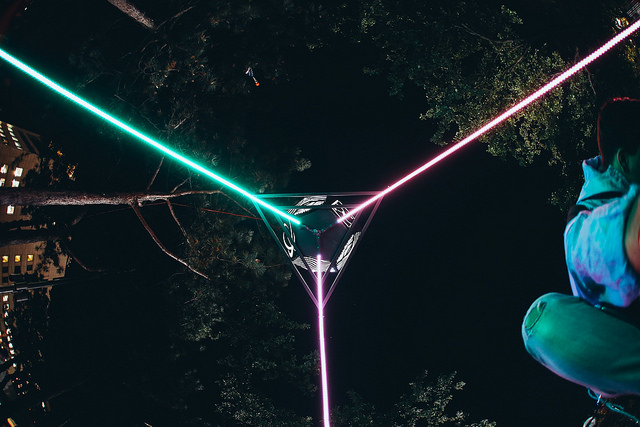
Movement Electronic Music Festival (Nick Kassab | Detroit Music Magazine)
And then sometimes you do wait for the drop, you get it, and you just keep falling and falling. The Floorplan drops beneath you. Performing under his alias, Robert Hood gave us a euphoric free fall through the aforementioned Ground Techno until we emerged into an atemporal “space.” In fact, on screen we saw an astro/psychonaut spinning in limbo as the set went on. Floorplan’s brand of techno is spacious, but it connects to both psychedelic music in that it mines inner space, and it links to progressive music in its exploration of outer space. Someone nearby me said he felt like a “techno redneck,” during Hood’s killer set. We were in uncharted territory, indeed.
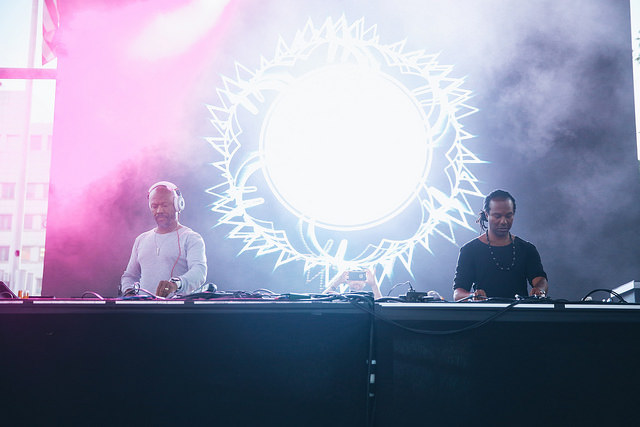
Floorplan on the Thump Stage (Nick Kassab | Detroit Music Magazine)
One other association that Floorplan made with techno’s history was its roots in disco, and how both styles of music take pleasure in rigor and restraint. I had just run into a former coworker at the start of this set, and here we were, on the weekend. Everybody’s working for it, after all. Sure enough, a sample Hood used cried out “Working behind the scenes.” The grind of the workweek becomes the grind of lovemaking becomes a grinding beat.
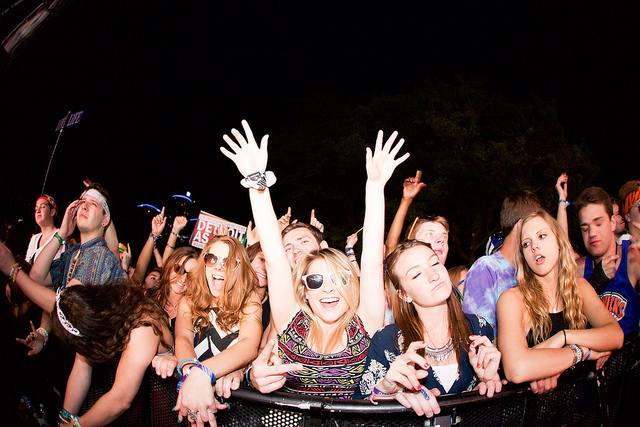
Movement Electronic Music Festival (Nick Kassab | Detroit Music Magazine)
Another diva vocal started singing, “There’s something ’bout this song that makes me feel good.” And yet the beats behind her disembodied voice still sounded like the computers we work with every single day. We employ these machines that dispirit and dehumanize us, but then we exalt them. Is it any wonder that the music most stereotyped for being “soulless” is also most associated with a drug named after its euphoric properties?
This string of thought was interrupted by another sample, this time of Disclosure’s “When a Fire Starts to Burn,” and when the song’s preacher spoke of that fire spreading, it was hard not to think of techno’s fire spreading throughout the world. The music has truly become international, and Movement is proof of that.
Back at the Red Bull Music Academy, hip-hop enthusiasts were in for a real treat, as one of the Wu-Tang Clan was in the house (or in the plaza). Clifford Smith, better known as Method Man, took to the stage guns blazing and delivered a set soaked in ’90s nostalgia. In an odd juxtaposition of retromania and nowness, when Method asked the audience if they remembered that decade to put their hands up, nearly all those hands had smartphones in tow. Still, this show did not disappoint. Method stormed the crowd and spilled champagne over the first few rows, but no one seemed to mind. His undeniable charisma as he took the audience through such indelible hits as “Bring the Pain” brought everyone much pleasure.
Next up on the Thump Stage was Carl Craig, who recently launched his “Detroit Love” project to spread the fire and passion for techno internationally. His opening number elevated the music to spiritual proportions, depicting the city’s industry as religion, the factory as church, techno as gospel, the man-machine. When his set ran into technical issues, it could have been a crisis of faith, but as Detroiters, we have had our fair share of hard knocks. We keep the hope alive. When the sound was restored, a computerized voice chirping “music nonstop” seemed to also be saying “ha ha ha,” as if acknowledging the irony of the interruption. Detroit also has a sense of humor.
On the way over to Disclosure’s DJ set, you could see below into the ramp leading to the Underground Stage that someone had written “SPREAD NOTHING.” Unfortunately, that sentiment would fall on deaf ears as the English duo pulled out songs that began with nods to Detroit’s techno roots before leaning more heavily on their own affinity for 2-step and UK garage. Howard and Guy Lawrence, the latter of whom turns twenty years old tomorrow, represent a meeting point between dance, pop, and electronic music, and their DJ set reflected this. Although it didn’t borrow much if anything from their acclaimed LP Settle, they wowed the crowd and proved they are a force to be reckoned with.
Twenty years ago, Richie Hawtin might have been playing on the Underground Stage. With his crystalline shards of drums and spare, scintillating knife-blade synths, how did the artist also known as Plastikman translate to the big time? How does minimal techno sound writ large? It turns out the Movement Stage is an apt home for the English-born but Detroit-by-proxy artist, as his lean beats have all the propulsion of a tank with more horsepower. His streamlined rhythmic patterns leave little room for drag, and his set surged like a hovercraft. Rather than herk and jerk, Hawtin just soared. He looked like a captain on the bridge of a spaceship. And when he set engines for engage, that he did, with the audience — who seemed of a unit — moving in unison to the course Hawtin had set. It was a stellar finish to the first night of an incredible first day of Movement 2015.
See more photos from the first day of Movement 2015, including additional pictures of Method Man and Disclosure, below:
Stay tuned tomorrow and Monday for our continuing coverage of Movement Electronic Music Festival!
